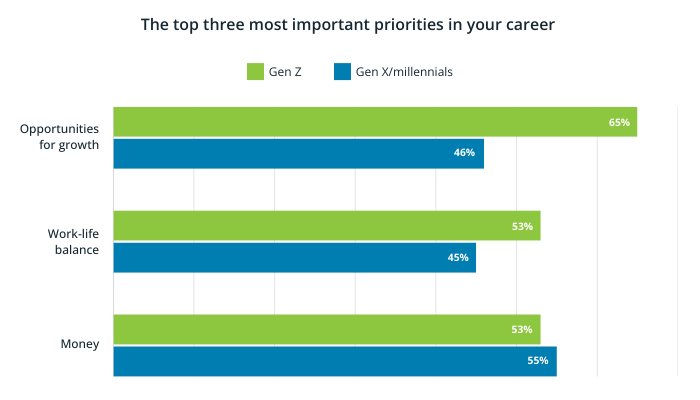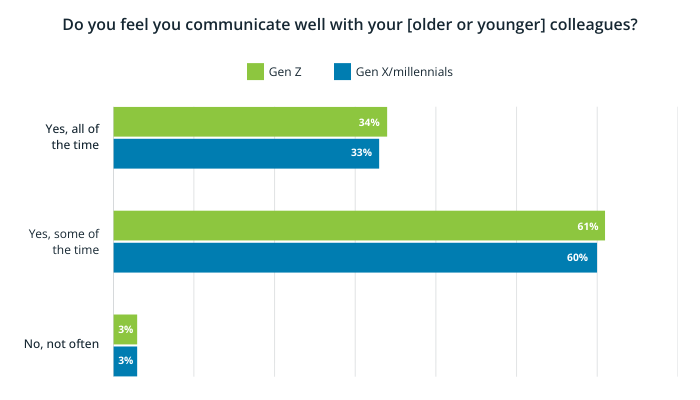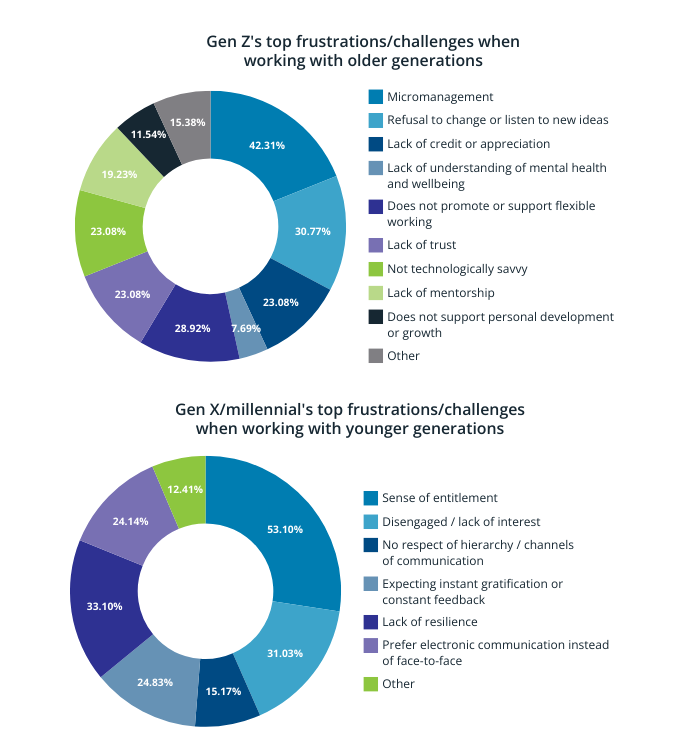The top 4 challenges for age-diverse workplaces and how to overcome them
December 14, 2023Career growth and healthy company cultures are still top priorities for employees in the workplace today, our latest survey in APAC has revealed.
Weeks ago, we discussed the advantages to a multigenerational workforce, including how to best foster a thriving environment despite challenges managing age-diverse groups. Our survey findings included more than 200 employee responses from all generations across APAC. Respondents answered questions about preferred working styles, challenges with other generations, career priorities, and more. Of those surveyed, 13% of respondents were Gen Z, 60% were millennials, 23% were Gen X, and 2% were Baby Boomers.
Our approach was based on differentiating opinions between generations. As such, for the second part of the survey, we split the questions based on respondents self-identifying what generation they were from, with Gen Z being in one category and millennials/Gen X/Baby Boomers being in the other. This allowed us to compare preferences. View the takeaways and see how you can implement these insights into your business plan for 2024 and beyond.
#1: A healthy work culture topped everyone’s career priorities
Survey results: All generations surveyed mentioned a healthy work culture as one of their top three most important career priorities. 38% of respondents in Gen Z mentioned this, as well as 46% of Gen X and millennials (tied with growth opportunities).
What this means: Regardless of demographic, everyone wants a place where they’re both respected and heard at work. Promoting and fostering a positive workplace culture is key to actively bringing generational groups together. It’s also a differentiator toward a happier and more productive workforce. For leaders, consider tailoring communication preferences, flexible work arrangements and team members’ strengths to know how to ensure everyone’s voices are factored into projects. The
Action items:
- Offer additional perks and wellness activities to incentivize employee happiness
- Clearly communicate the organisation’s long-term goals for employees to achieve growth and alignment in their careers
- Prioritise meaningful relationships over transactional ones
#2: “More growth opportunities, please,” said everyone
 Survey results: All generations surveyed revealed a hunger for growth. 65% of Gen Z expressed this as one of their top three career priorities, as did 46% of millennials and Gen X (with work-life balance closely behind at 45%).
Survey results: All generations surveyed revealed a hunger for growth. 65% of Gen Z expressed this as one of their top three career priorities, as did 46% of millennials and Gen X (with work-life balance closely behind at 45%).
What this means: No matter what phase of their career survey respondents were in, a prominent desire for ongoing training, development and mentorship made itself known. This affirms the value of today’s skill-based market for continuous learning. If L&D courses aren’t in the budget, there’s free options available as well. Additionally, there’s an incredible amount your team members can learn from each other, too, if given the time and space. Whether it’s technology adoption or fulfilment through giving back, employees unanimously agree across generations that learning and development is a top priority to further careers and encourage age diversity.
Action items:
- Upgrade your talent mobility program
- Encourage mentorships for employees of all levels (not just entry level)
- Offer flexible learning options to suit every generation
#3: The disconnect is mutual

Survey results: When asked whether older and younger generations communicated well together, all generations agreed they did “some of the time.” 61% of Gen Z said they did some of the time with older generations, while Gen X and millennials responded with the same answer one percent point lower at 60%. The same percentage difference applied with yes (34% and 33%, respectively), and 3% for all groups responded no.
What this means: A (mutually agreed-upon) disconnect clearly exists between communication styles — verifying the qualitative data gathered in our previous post. Technology’s rapid development has strained the way generations communicate, causing friction in the workplace. Younger generations prefer instant messaging, whereas older generations typically prefer face-to-face calls. The best way to bridge the gap? Schedule a blend of in-person team calls and group chats to keep collaboration at an all-time high — this ensures everyone stays on the same page.
Action items:
- Evaluate the preferences on your team and adjust accordingly
- Ask employees what works for them regularly
- Encourage hybrid working models to meet the best of employees’ communication styles
#4: Entitlement vs. micromanagement: Top workplace frustrations between generations

Survey results: One of Gen Z’s top challenges working with other generations from the survey is micromanagement, coming at 42% of respondents, followed by a refusal to change or listen to new ideas (30%). For Boomers, Gen X and millennials, 53% noted a sense of entitlement in younger colleagues was their top frustration, followed by 33% noting a lack of resilience.
What this means: Older generations feel younger employees ought to be more resilient to change and willing to put in the hard work, while younger employees feel they are limited by overbearing processes without being heard out to explore new approaches. Finding a middle ground in an age diverse workplace involves a multi-pronged approach — to exercise innovation without sacrificing the foundational success that’s been built.
Action items:
- Review processes regularly to identify bottlenecks
- Listen to team members on ways to improve, and implement changes gradually
- Bake in collaboration time with everyone weekly to stay tuned in (especially across hybrid or remote environments)
What HR leaders are saying
Although stressful to navigate, our multigenerational survey revealed ways to bridge the gap in differences and foster a healthy, happy workplace environment. We hope these action items gave you consideration points for your business plan next year and beyond. Above all, listen to your employees and take a flexible approach to the way age groups collaborate — and innovation is sure to follow.
About Ramona Soares
Ramona is a highly commercial, dynamic and results driven HR recruitment professional with more than 15 years' experience in talent acquisition across Europe, USA, Middle East, Africa and Asia. She has exposure and experience dealing with the latest recruitment technologies and online tools coupled with strong people management and leadership skills and a keen emphasis on team development and performance management. Ramona is an excellent communicator and stakeholder manager with a clear focus on delivering positive results.



